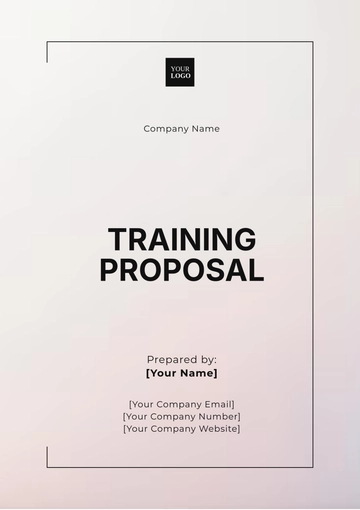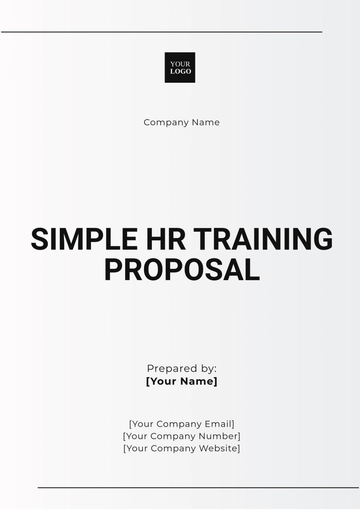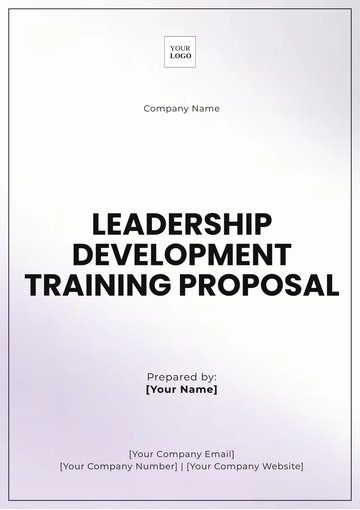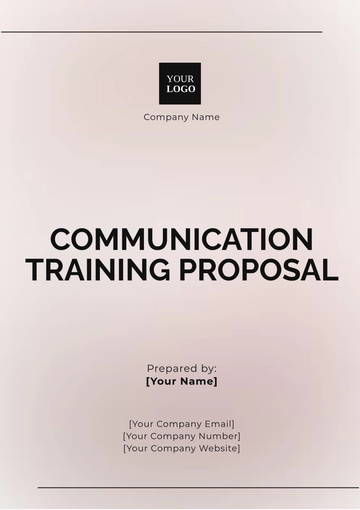Free Strategic Employee Training Proposal

Prepared by: [Your Name]
Company: [Your Company Name]
Date: [Date]
I. Executive Summary
This proposal outlines a strategic plan for the development and implementation of a comprehensive employee training program at [Your Company Name]. The key objectives of the training initiative are to enhance employee skills, boost performance, and ensure that employee development is strategically aligned with the organization's goals and values.
By employing diverse training methodologies and adhering to a structured timeline, we aim to deliver impactful learning experiences. A well-defined budget and evaluation metrics are included to facilitate tracking and reporting, ensuring return on investment and achievement of training objectives.
II. Training Objectives
The primary objectives of the employee training program are:
A. Skill Development
To provide employees with the necessary skills and knowledge to perform their job roles effectively and efficiently. This includes:
Technical Skills Training: Focus on job-specific skills that enhance productivity.
Soft Skills Development: Programs to improve communication, teamwork, and problem-solving abilities.
B. Leadership Development
To enhance leadership skills and prepare future leaders within the organization by offering:
Leadership Workshops: Interactive sessions focusing on strategic thinking and decision-making.
Succession Planning: Identifying potential leaders and providing them with tailored development opportunities.
C. Continuous Improvement
To foster a culture of continuous improvement and innovation through:
Feedback Mechanisms: Encouraging employee input on processes and practices.
Innovation Workshops: Training sessions focused on creative thinking and process improvement methodologies like Lean and Six Sigma.
D. Strategic Alignment
To ensure that training aligns with long-term organizational strategy and goals, we will:
Conduct Regular Assessments: Regularly review and adjust training programs based on evolving organizational goals.
Engage Leadership in Training Initiatives: Involve management in the planning process to ensure alignment with business objectives.
III. Target Audience
A. Employee Levels
The training program will target multiple employee levels within the organization, including:
Entry-Level Employees: Focused on foundational skills and knowledge.
Mid-Level Managers: Training on team management and strategic decision-making.
Senior Executives: Advanced training on organizational leadership and strategic vision.
B. Departmental Focus
Focus will also be directed at specific departments that require specialized training, such as:
Sales and Marketing: Training on digital marketing strategies and sales techniques.
Human Resources: Programs focused on talent management and employee engagement strategies.
Information Technology: Technical training on emerging technologies and cybersecurity protocols.
Operations: Training in process optimization and supply chain management.
IV. Training Methods
The training will be delivered through a variety of methods to accommodate different learning styles and preferences:
A. Classroom Training
Interactive sessions facilitated by experienced trainers emphasize:
Group Discussions: Promoting knowledge sharing and collaboration.
Case Studies: Real-world scenarios to apply learning in practical contexts.
B. E-learning Modules
Self-paced online courses accessible via the organization's Learning Management System (LMS), featuring:
Multimedia Content: Engaging videos and interactive quizzes.
Trackable Progress: Employees can monitor their learning journey and achievements.
C. Workshops and Seminars
Hands-on workshops to develop practical skills, including:
Skill-Specific Workshops: Focused sessions for areas such as project management or customer service excellence.
Guest Speaker Seminars: Inviting industry experts to share insights and experiences.
D. Mentoring and Coaching
One-on-one mentoring and coaching programs to support individual development paths by:
Assigning Mentors: Experienced employees guide less experienced ones in their career growth.
Personalized Development Plans: Tailored coaching sessions to address individual goals and challenges.
V. Timeline
Phase | Activities | Duration |
|---|---|---|
Phase 1 | Needs Assessment and Program Design | Month 1-2 |
Phase 2 | Development of Training Materials and Modules | Month 3-4 |
Phase 3 | Training Deployment and Implementation | Month 5-6 |
Phase 4 | Evaluation and Feedback | Month 7 |
VI. Budget
The estimated budget for the entire training program is outlined below:
Category | Estimated Cost |
|---|---|
Training Materials and Resources | $10,000 |
Facilitator Fees | $15,000 |
Technology and LMS Costs | $5,000 |
Miscellaneous Expenses | $2,000 |
Total | $32,000 |
The budget will be reviewed quarterly to ensure alignment with actual expenditures and training outcomes.
VII. Evaluation Metrics
The effectiveness of the training program will be measured through the following means:
Employee Feedback Surveys: Collecting qualitative and quantitative data on participant satisfaction and perceived value.
Pre- and Post-Training Assessments: Evaluating knowledge and skill improvements as a result of the training.
Performance Metrics Analysis: Reviewing performance indicators to assess the impact of training on job performance.
Return on Investment (ROI) Calculation: Analyzing financial metrics to determine the cost-effectiveness of the training program.
VIII. Appendices
A. Appendix A: Needs Assessment Data
Includes results from surveys and interviews conducted with employees and management to determine training needs, along with charts and graphs to illustrate key findings.
B. Appendix B: Detailed Curriculum Vitae of Trainers
Profiles and qualifications of the trainers involved in delivering the program, showcasing their expertise and previous training experience.
C. Appendix C: Pre-Training and Post-Training Survey Templates
Sample templates of surveys to be used for capturing participant feedback, designed to gather insights on both content and delivery.
D. Appendix D: Additional Resources
Links and references to supplementary learning materials and recommended reading to enhance training outcomes and promote self-directed learning.
- 100% Customizable, free editor
- Access 1 Million+ Templates, photo’s & graphics
- Download or share as a template
- Click and replace photos, graphics, text, backgrounds
- Resize, crop, AI write & more
- Access advanced editor
Plan strategic employee development with the Strategic Employee Training Proposal Template from Template.net. This editable and customizable template provides a professional structure for outlining employee training goals and methods. Easily customize it to your company's needs, and make adjustments efficiently, as it’s fully editable in our AI Editor Tool for hassle-free editing.
You may also like
- Business Proposal
- Research Proposal
- Proposal Request
- Project Proposal
- Grant Proposal
- Photography Proposal
- Job Proposal
- Budget Proposal
- Marketing Proposal
- Branding Proposal
- Advertising Proposal
- Sales Proposal
- Startup Proposal
- Event Proposal
- Creative Proposal
- Restaurant Proposal
- Blank Proposal
- One Page Proposal
- Proposal Report
- IT Proposal
- Non Profit Proposal
- Training Proposal
- Construction Proposal
- School Proposal
- Cleaning Proposal
- Contract Proposal
- HR Proposal
- Travel Agency Proposal
- Small Business Proposal
- Investment Proposal
- Bid Proposal
- Retail Business Proposal
- Sponsorship Proposal
- Academic Proposal
- Partnership Proposal
- Work Proposal
- Agency Proposal
- University Proposal
- Accounting Proposal
- Real Estate Proposal
- Hotel Proposal
- Product Proposal
- Advertising Agency Proposal
- Development Proposal
- Loan Proposal
- Website Proposal
- Nursing Home Proposal
- Financial Proposal
- Salon Proposal
- Freelancer Proposal
- Funding Proposal
- Work from Home Proposal
- Company Proposal
- Consulting Proposal
- Educational Proposal
- Construction Bid Proposal
- Interior Design Proposal
- New Product Proposal
- Sports Proposal
- Corporate Proposal
- Food Proposal
- Property Proposal
- Maintenance Proposal
- Purchase Proposal
- Rental Proposal
- Recruitment Proposal
- Social Media Proposal
- Travel Proposal
- Trip Proposal
- Software Proposal
- Conference Proposal
- Graphic Design Proposal
- Law Firm Proposal
- Medical Proposal
- Music Proposal
- Pricing Proposal
- SEO Proposal
- Strategy Proposal
- Technical Proposal
- Coaching Proposal
- Ecommerce Proposal
- Fundraising Proposal
- Landscaping Proposal
- Charity Proposal
- Contractor Proposal
- Exhibition Proposal
- Art Proposal
- Mobile Proposal
- Equipment Proposal
- Student Proposal
- Engineering Proposal
- Business Proposal





























